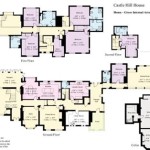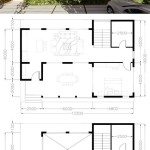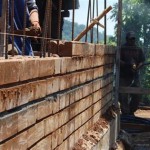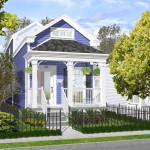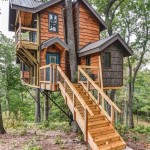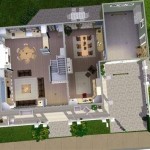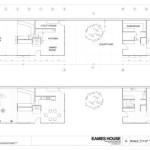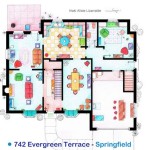House Plans for Narrow Lots
Building a house on a narrow lot presents unique challenges, but with thoughtful planning, it's possible to create a comfortable and stylish home. Careful consideration of layout, design elements, and local building codes can transform a seemingly restrictive space into an efficient and attractive dwelling.
One of the primary considerations for narrow lot house plans is maximizing the available space. This often involves building upwards rather than outwards. Multi-story designs are common, allowing for a smaller footprint while still providing ample living space. These designs often incorporate open-plan living areas to create a sense of spaciousness despite the limited width.
Vertical space can be further maximized through the incorporation of basements or attic conversions. Basements can provide additional living areas, such as recreation rooms, home offices, or extra bedrooms. Finished attics can serve similar purposes, adding valuable square footage without expanding the home's footprint.
Strategic placement of windows and doors plays a crucial role in maximizing natural light and ventilation in narrow lot homes. Large windows, particularly those facing the street, can create a sense of openness and bring in abundant natural light. Clerestory windows, positioned high on the wall, can further enhance natural light penetration without compromising privacy.
Courtyards and balconies offer additional outdoor living space and enhance the sense of spaciousness. A small courtyard can provide a private outdoor retreat, while a balcony off a bedroom or living area can extend the living space outwards.
Choosing the right architectural style can also significantly impact the functionality and aesthetic appeal of a narrow lot home. Certain styles, such as contemporary or minimalist designs, often lend themselves well to narrow lots due to their clean lines and efficient use of space. These styles often prioritize functionality and simplicity, making them ideal for maximizing limited square footage.
When selecting a house plan for a narrow lot, it's essential to consider the local building codes and zoning regulations. These regulations often dictate setback requirements, building height restrictions, and other factors that can impact the design and construction of the home. Consulting with a local architect or builder can ensure compliance with these regulations and facilitate a smooth building process.
Garage placement is another crucial consideration for narrow lots. Attached garages can further restrict the width of the living space, while detached garages may not be feasible due to limited lot size. Tandemt garages, where cars are parked one behind the other, can be a practical solution in some cases. Alternatively, incorporating off-street parking in the front or rear of the property may be necessary.
Privacy is often a concern with narrow lot homes, particularly in densely populated areas. Careful placement of windows and landscaping can help maintain privacy. Frosted glass, strategically placed shrubs, or privacy fences can create a sense of seclusion without completely blocking natural light and ventilation.
Interior design choices can also contribute to the overall feeling of spaciousness within a narrow lot home. Light color palettes for walls and furniture can make rooms appear larger and brighter. Minimalist decor and strategically placed mirrors can further enhance the sense of openness. Using vertical storage solutions, such as tall bookshelves and cabinets, can maximize storage space without cluttering the floor area.
The orientation of the house on the lot is another important factor to consider. Positioning the long side of the house perpendicular to the street can maximize the width of the living space and allow for more natural light penetration. This orientation can also create a more private backyard area.
Incorporating sustainable design features can enhance both the environmental friendliness and the long-term cost-effectiveness of a narrow lot home. Energy-efficient windows, insulation, and appliances can reduce energy consumption and lower utility bills. Rainwater harvesting systems and solar panels can further reduce the home’s environmental impact.
Working with a qualified architect or designer specializing in narrow lot homes can ensure that the design maximizes the available space and meets the specific needs and preferences of the homeowner. They can provide valuable insights into design options, material choices, and construction techniques that are best suited for narrow lot construction.
Ultimately, building on a narrow lot requires a thoughtful approach that balances functionality, aesthetics, and compliance with local regulations. Careful planning and collaboration with experienced professionals can result in a beautiful and efficient home that perfectly suits the constraints and opportunities of a narrow lot.

Simple Narrow Lot House Plans Houseplans Blog Com
House Plan Of The Week Narrow And Luxurious Builder

Simple Narrow Lot House Plans Houseplans Blog Com

2 Story House Plans For Narrow Lots Blog Builderhouseplans Com

Budget Friendly Narrow Lot House Plan

Narrow Lot Ranch House Plan 22526dr Architectural Designs Plans Narrowmasterbathro Rectangle

Narrow House Plans For Lots Homes By Mark Stewart Home Design

House Plan 940 00235 Narrow Lot 740 Square Feet 2 Bedrooms 1 Bathroom Plans Small Floor
House Plan Of The Week Narrow And Luxurious Builder

Plan 056h 0005 The House

